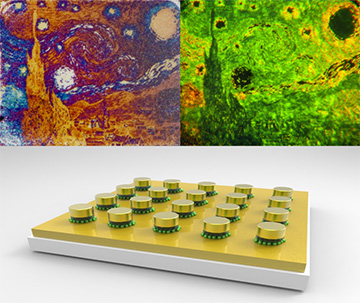
Tunable resonator-upconverted emission (TRUE) color prints of “The Starry Night” (Vincent van Gogh, 1889) taken under ambient light (top left) and light from a near-infrared continuous-wave laser (top right). An illustration of a TRUE resonator shows upconversion nanoparticles (green beads) embedded between a layer of aluminum nanodisks and a continuous layer of aluminum (bottom). [Image: Courtesy of SUTD]
Scientists from the Singapore University of Technology and Design (SUTD) report a new platform for optical security printing that uses upconversion nanoparticles (UCNPs) to create high-resolution multicolor images that change when viewed in ambient light and under near-infrared (NIR) light (Adv. Mater., doi: 10.1002/adma.201807900). The key to the platform, called tunable resonator-upconverted emission (TRUE) color printing, is a novel aluminum-based plasmonic resonator design embedded with lanthanide-doped UCNPs.
During demonstrations, team lead Joel K.W. Yang and his colleagues used a single excitation light source to coax a range of luminescent colors from the plasmonic resonators. When the resonators were employed as pixels to create security images, the researchers reported bright, multicolored plasmonic/luminescence images with resolutions reaching nearly 50,000 dpi. The researchers say that their TRUE printing platform could find use in anti-counterfeit applications for money, documents and medications.
Overcoming upconversion limitations
UCNPs are currently used as a type of “invisible ink” in optical document security. When UCNPs in these documents are exposed to light from a near-IR continuous-wave (CW) laser, they absorb the NIR wavelengths and emit upconverted higher-energy wavelengths in the visible or ultraviolet (UV) range, revealing a secret message or image.
However, today’s UCNP-based optical document security is limited by its low emission efficiency and resolution, and the need for additional UCNP species or light sources for different luminescence colors. The SUTD team believes that it may have overcome these hurdles with TRUE color printing by providing a platform that simplifies multicolor image fabrication and improves emission efficiency and print resolution.
Brighter and more colorful secret images
The SUTD researchers used a novel nanofabrication technique to create the plasmonic resonators used as “pixels” in their TRUE color-printing platform. Each resonator consists of a self-assembling monolayer of lanthanide-doped UCNPs between a 2x2 array of aluminum nanodisks and a solid aluminum back-reflector. (The resulting device resembles a nano-sized Lego piece.)
The resonator displays a visible color in ambient light based on the size of the nanodisks, and reveals a luminescence color under NIR light that can be manipulated by changing the emission channels of the UNCPs (that is, by tuning the plasmonic resonance of the nanodisks and matching this with the energy steps of lanthanide ions). While evaluating the resonators, the SUTD team found that the strong electromagnetic fields generated in the gap between the aluminum nanodisks and back-reflector increased luminescence brightness by two orders of magnitude.
The researchers used TRUE resonators to create several optical security prints to demonstrate their platform’s ability to hide luminescent messages in plasmonic images. These prints include a colorful butterfly that reveals the letters “UCNP” on one wing and a soccer ball on the other when excited by a near-IR CW laser. Another print, a rendition of Vincent van Gogh’s “The Starry Night,” has a corresponding luminescent image with a different color scheme when viewed with the NIR CW laser.
